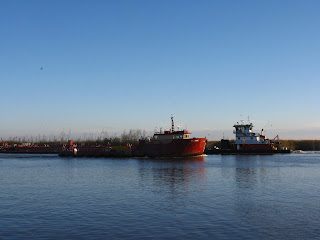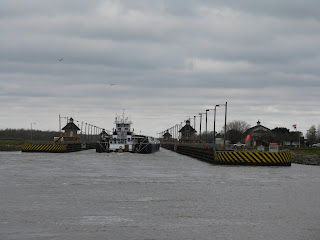 After leaving Morgan City we went through a winding path past many drainage canals and bayous. One industry in this part of Louisiana is salt. Morton Salt Company mines salt from the nearby Weeks Island salt dome. These buildings are part of the facility.
After leaving Morgan City we went through a winding path past many drainage canals and bayous. One industry in this part of Louisiana is salt. Morton Salt Company mines salt from the nearby Weeks Island salt dome. These buildings are part of the facility.In spite of often having to take a boat to go hunting. Hunting blinds are common on the sides of the Intercoastal Waterway.

From this area all the way south in Texas we see well heads. This remainders from oil well drilling lie in canals as well as bays and bayous.
Just south of this is the canal that leads to Avery Island - the home of Tabasco Sauce. Boats can go up the canal several miles and tie up at a fee dock and walk the 1/2 mile to the Tabasco Factory and gift shop. We weren't too "hot" on that idea.
 The waterway has opened up and straightened as we head south. The land is fairly flat. Actually the Weeks Island salt dome is the tallest hill for many miles.
The waterway has opened up and straightened as we head south. The land is fairly flat. Actually the Weeks Island salt dome is the tallest hill for many miles.
On New Years Eve we reached a supply and refueling station called Shell Morgan Landing. Everyone left at noon for the holiday so we tied up to the bulkhead. Large Shrimp boats moor in the area. This spot is Intercoastal City. It is a hub for supply boats for off shore oil rigs.
 These are examples of the Crew Boats that service the off shore rigs. Supplies are in the holds are bolted to the deck for the trip out to the deep water wells. Crew are ferried out also since they often work a two week on/two week off schedule.
These are examples of the Crew Boats that service the off shore rigs. Supplies are in the holds are bolted to the deck for the trip out to the deep water wells. Crew are ferried out also since they often work a two week on/two week off schedule.
Many crew are transported to the wells by helicopter. During the evening I counted over a dozen helicopters landing at a building about a 1/2 mile away from us.

Commercial ship and well supply operations line the waterway near Intercoastal City. Shipyards repair crew boats. There are fuel supplies as well as drill mud.

On New Year's Day we reached the Leland-Bowman Locks. Another one of the locks on this route built to block saltwater intrusion from the Gulf of Mexico into freshwater streams. When fresh water levels are high enough the gates are open and you just motor through with out the gates being closed.

Maybe not wildlife but this goat was certainly an unusual sight on our trip.
Drainage canals lace the land. Often pumps on land pump water out of the low lying areas into the canal.

Must be a bird committee meeting.
Pelicans have their political conventions also.

Drilling still goes on. This is the typical small land based drilling well.
I was amazed by the variety of loads being transported on the intercoastal. This load looked like a reel of yellow tubing....but it was huge.

On the 2nd we reached Texas. We have anchored two nights in bends of rivers that were off the Intercoastal Waterway. Now we are back in civilization as we pass through Port Arthur Texas. We saw several pleasure boats marooned on land. We assume this is hurricane Ike aftermath.
Shrimping and fishing are still big in Port Arthur. However, we did see many refineries around the town.

















































